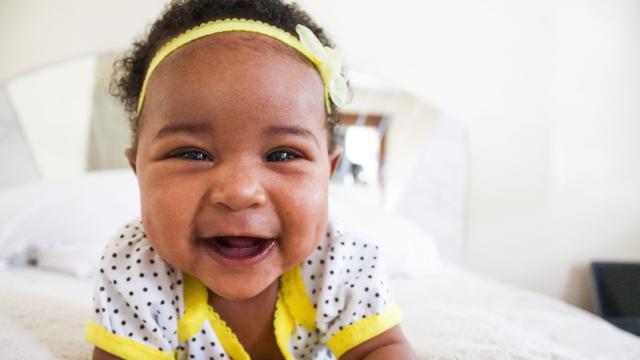New parents hear the advice often: You need to talk to your baby! A lot! The book SuperBaby proclaims 30,000 words a day is the magic number for optimal language success. One landmark study found that kids who heard 45 million words by age three later scored the highest in reading and maths. There’s even a wearable word counter that you can clip onto your infant’s onesie and see via an app whether you’re meeting your daily word goals. Basically, a verbal Fitbit.
Photo: Shanice McKenzie (Pexels)
When my daughter was a baby, I made it the utmost priority to ensure she heard all the words. I’d rattle off the names of all the different types of pastas in the supermarket as she’d stare at me in the shopping cart. I sang “Don’t Cry for Me, Little Baby” to the tune of “Don’t Cry For Me Argentina”. I read her the latest celebrity news in Us Weekly (hey, two-month-olds don’t get a choice in their literature). I talked and talked and talked some more, having learned that the earliest moments of a child’s life are critical for language development.
Now, though, in 2018, it might be time to rethink the word dump. MIT researchers have discovered something new: To really set up a path for strong literary skills, it isn’t enough to talk to your child. Instead, you must talk with them.
From MIT News:
MIT cognitive scientists have now found that conversation between an adult and a child appears to change the child’s brain, and that this back-and-forth conversation is actually more critical to language development than the word gap. In a study of children between the ages of 4 and 6, they found that differences in the number of “conversational turns” accounted for a large portion of the differences in brain physiology and language skills that they found among the children. This finding applied to children regardless of parental income or education.
The study, which compared the brain scans of children to data captured through audio recordings, was done with children ages four to six, but the researches say there are takeaways for parents of younger children. “Even from infancy, we can consider children to be conversational partners,” said Rachel Romeo, the lead author of the paper, which was published in Psychological Science. “… It seems to be the interaction that best supports children’s language skills and the underlying neural development.”
That means don’t stop talking to your baby, but do let his non-verbal cues and responses help guide the “conversation”. Here are some ways to do it:
Have a back-and-forth dialogue. For example, you: “Did you see the bus go by?” Baby: “Puh Gah Oooh.” You: “Yes, it was big and yellow!”
Read books interactively. If your baby seems to be staring at a certain character or object in a book, you can expand on it, saying, “Oh, you seem very interested in the tortoise! Look, it has a shell! I wonder what it ate today.”
Exchange coos and sounds. If your baby squeals, you can mimic it, going back and forth as if it’s a game.
[referenced url=”https://www.lifehacker.com.au/2018/02/read-stories-with-specific-character-names-to-boost-babies-brains/” thumb=”https://i.kinja-img.com/gawker-media/image/upload/t_ku-large/xlqnpepkp4gto54u1erm.jpg” title=”Read Stories With Specific Character Names To Boost Babies’ Brains” excerpt=”Most of us know that reading to babies is a very good thing – it’s tied to language and cognitive development, helps strengthen the parent-child bond, and gives us a welcome script when we’re trying to get in our recommended 30,000 words a day without having to rap the Fresh Prince of Bel-Air theme song yet again. But for optimal benefits, it may not be enough to simply grab any board book or Thai takeaway menu and start rattling off the words. According to a new study, the type of book you read may make a big difference.”]
Ask before picking up your baby. Parenting educator Janet Lansbury suggests asking “Do you want me to pick you up? or “Are you ready for me to pick you up?” – and then waiting a moment. “This gives babies a wonderful opportunity to communicate their needs or wants,” she writes. “Young infants learn on their own to lift their arms, move their hands, or otherwise signal readiness.”
Expand on their sounds. When my daughter was a baby, she would say “mih” when she wanted milk. Expand on their early attempts at talking. “You want some milk? Sure! Here’s some milk! Thank you for asking.”
Look your baby in the eye. It isn’t enough for your child to listen to conversations you’re having with other people. Speak directly to the infant, and then listen to what she has to say.

Comments
3 responses to “How To Have A ‘Conversation’ With A Baby ”
As a new dad this is fascinating stuff.
I’m not sure why, but from the first day I spoke to my little fella like he is a person, told him about my day at work, asked him about his and generally chatted away like he can understand the English language.
Lately I have actually reverted to speaking to him like a baby but that was because he likes to look at me like I’m an annoying idiot (he took his mothers resting bitch face, her words, not mine) so I think I might go back to talking properly to my little poop goblin.
Yeah ‘they’ do say speak to them and respond to them as if they are were an adult is beneficial. But sometimes speaking in baby talk also helps engage them (and the babies love it)
That sounds a bit ridiculous, 30,000 words a day !!
With kids 0 – 3 sleeping an average 12 hours a day, that gives you 12 hours for 30,000 words or 2,500 words an hour, or 42 words a minute for the entire time they are awake i don’t think thats all that feasible …. although my 4yo often sounds like she speaks at 10,000 words an hour.